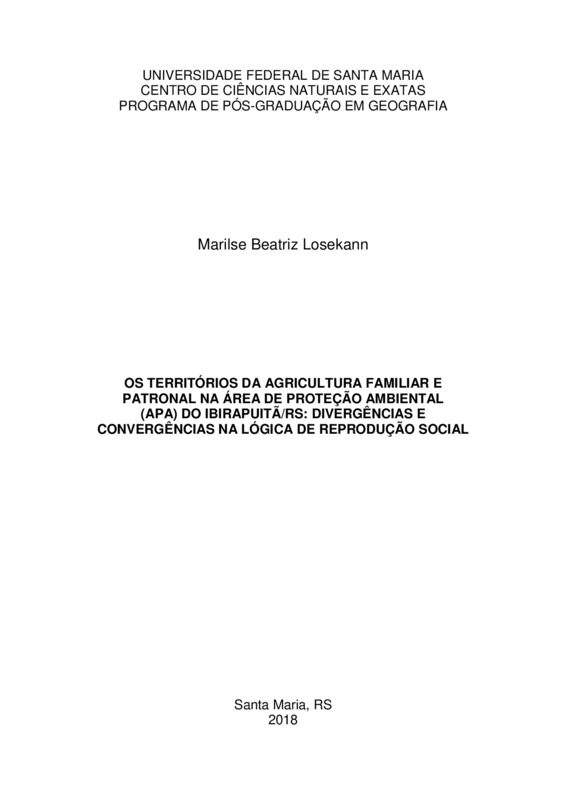-
Título
-
OS TERRITÓRIOS DA AGRICULTURA FAMILIAR E PATRONAL NA ÁREA DE PROTEÇÃO AMBIENTAL (APA) DO IBIRAPUITÃ/RS: DIVERGÊNCIAS E CONVERGÊNCIAS NA LÓGICA DE REPRODUÇÃO SOCIAL
-
lista de autores
-
MARILSE BEATRIZ LOSEKANN
-
Resumo
-
Este trabalho apresenta um estudo acerca dos territórios e territorialidades dos agricultores patronais e familiares que vivem na Área de Proteção Ambiental (APA) do Ibirapuitã, Unidade de Conservação de Uso Sustentável do Bioma Pampa, Rio Grande do Sul. Visa compreender quais as estratégias de reprodução social são empregadas assim como as adaptações às normas da Unidade de Conservação. O estudo é embasado pela pesquisa qualitativa e dentre os instrumentos e técnicas foram utilizados a pesquisa bibliográfica e documental, o trabalho de campo, entrevistas semiestruturadas, observação sistemática, uso de fotografias e por fim a análise e discussão das informações. Os resultados demonstram que no território da Unidade de Conservação denominada APA do Ibirapuitã, ainda predomina a pecuária extensiva sobre o campo natural, configurando a manutenção das características culturais e ambientais locais do Bioma Pampa, e a manutenção da coexistência histórica da agricultura patronal e familiar. Algumas práticas tradicionais como o descapoeiramento se apresentam como conflituosas às normativas legais da UC. Dentre as principais estratégias de reprodução social encontram-se, tanto entre os patronais quanto entre os familiares: a auto-organização como as Associações dos Produtores do Rincão do 28 e do Rincão do Batista, a Comunidade Quilombola Rincão da Chirca, bem como formas de cooperação não institucionalizadas como a venda conjunta de animais por vizinhos que mantêm características produtivas semelhantes; o arrendamento ou parceria; a introdução do discurso e de práticas sustentáveis que vem contribuindo para a conservação da APA; e a inserção da mulher na tomada de decisão e nas atividades diárias das lidas campeiras, estratégia essa utilizada nos territórios familiares. O CONAPA, Conselho Gestor da APA, se configura como instrumento dialógico entre os sujeitos e instituições que compõem o território da Unidade de Conservação, é necessário que ocorra o aumento da representatividade dos moradores do interior da APA, pois só assim é possível garantir que haja correspondência das demandas da comunidade envolvida com o espaço protegido, assim como, é essencial que os encontros ocorram com regularidade. Para que esses problemas possam ser superados, é fundamental que as demandas estruturais da APA sejam sanadas, como a destinação de mais verbas e de analistas ambientais para APA.
-
Abstract
-
This work presents a study about the territories and territorialities of the farmers and family members who live in the Environmental Protection Area (APA) do Ibirapuitã, Unit of Conservation of Sustainable Use of the Pampa Biome, Rio Grande do Sul. It aims to understand which strategies of social reproduction are employed as well as the adaptations to the standards of the Conservation Unit. The study is based on qualitative research and among the instruments and techniques were used bibliographic and documentary research, field work, semi-structured interviews, systematic observation, use of photographs and finally the analysis and discussion of the information. The results show that in the territory of the Conservation Unit, APA do Ibirapuitã, extensive livestock management still prevails over the natural field, thus maintaining the local cultural and environmental characteristics of the Pampa Biome, and maintaining the historical coexistence of patronal agriculture and family. Some traditional practices such as decommissioning are presented as conflicting with the legal norms of the CU. Among the main strategies of social reproduction are, both among employers and among their families: self-organization such as the Associations of Producers of the Rincão do 28 and Rincão do Batista, the Quilombola Community Rincão da Chirca, as well as forms of non-institutionalized cooperation such as the joint sale of animals by neighbors which maintain similar productive characteristics; lease or partnership; the introduction of the discourse and sustainable practices that have contributed to the conservation of the APA; and the insertion of women in the decision-making and daily activities of the champions, a strategy that is used in the family territories. CONAPA, the Administrative Council of the APA, is configured as a dialogical instrument between the individuals and institutions that make up the territory of the Conservation Unit, it is necessary that there is an increase in the representativeness of the residents of the APA, since this is only possible to guarantee that there is correspondence of the demands of the community involved with the protected space, as well as, it is essential that the meetings occur regularly. For these problems to be overcome, it is critical that the structural demands of the APA be addressed, such as the allocation of more funds and environmental analysts to APA.
-
Palavras Chave
-
TERRITÓRIO
-
AGRICULTURA
-
ÁREA DE PROTEÇÃO AMBIENTAL
-
PAMPA
-
SUSTENTABILIDADE
-
Key Words
-
TERRITORY
-
AGRICULTURE
-
ENVIRONMENTAL PROTECTION AREA
-
PAMPA
-
SUSTAINABILITY
-
Tipo
-
DOUTORADO
-
Universidade
-
UNIVERSIDADE FEDERAL DE SANTA MARIA
-
Data
-
2018
-
Páginas
-
232
-
Localização
-
Biblioteca Digital de Teses e Dissertações (BDTD UFSM)
-
Orientador
-
CARMEN REJANE FLORES WIZNIEWSKY
-
Programa
-
Programa de Pós-Graduação em Geografia e Geociências
-
Sigla Universidade
-
UFSM
-
Área de Concentração
-
ANÁLISE AMBIENTAL E TERRITORIAL DO CONE SUL
-
Língua
-
Português
-
email
-
MARILOSEKANN@HOTMAIL.COM

